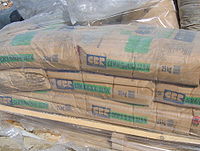
Photo from wikipedia
Abstract This paper presents an experimental investigation on the durability properties and carbon dioxide (CO2) emissions of concrete developed using waste products. The concrete comprised of recycled concrete aggregate (RA)… Click to show full abstract
Abstract This paper presents an experimental investigation on the durability properties and carbon dioxide (CO2) emissions of concrete developed using waste products. The concrete comprised of recycled concrete aggregate (RA) as a complete coarse aggregate replacement. In addition, rice husk ash (RHA), palm oil fuel ash (POFA) and palm oil clinker powder (POCP) were used as replacement materials for cement at levels up to 30%. The supplementary cementitious materials (SCMs) were used in RA concrete with the aim of reducing the dependency on cement as a stand-alone binder. The compressive strength, water absorption, chloride-ion penetration and electrical resistivity were investigated for RA concrete containing SCMs. Moreover, the residual compressive strength was also examined along with the weight loss to check the elevated temperature resistance of RA concrete with SCMs. The results revealed that the use of 30% RHA as SCM produced the highest compressive strength efficiency of 0.143 MPa/kg cement among all mixes at the age of 90 days. In addition, a significant enhancement was observed for the durability-related properties at later ages, although the engineering properties of RA concrete containing SCMs was low at the age of 28 days. The thermogravimetric (TG) analysis indicated that the RHA is more effective as a pozzolanic additive than POFA and POCP. The CO2 emissions from RA concrete were reduced by approximately 29% when it was incorporated with 30% SCM, where the eco-strength efficiency showed the highest values at 20% cement replacement level of 20%.
Journal Title: Journal of Cleaner Production
Year Published: 2018
Link to full text (if available)
Share on Social Media: Sign Up to like & get
recommendations!